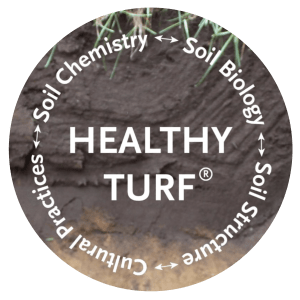Address Your Soil’s Needs & Grow Healthy Grass:
The impact of core aeration, overseeding, and calcium on turf.
8 minute read.
When it comes to Organic Turf Care, you need to address your soil’s needs. Healthy turf stands grow on healthy soils. Healthy soil has a balanced chemistry, consists of diverse biology, and is well structured. Compacted soils are mostly caused by high foot traffic – pedestrian or athletic – and cause a host of problems for turf grass. Primarily, a lack of porosity for root growth and water penetration creates weak turf stands. Consequently, weak turf stands have trouble competing with weeds, diseases and insects.
The fibrous roots of grass grow in air pockets within the soil. As soil conditions worsen, these air pockets disappear. This creates an environment suitable for broadleaf weeds with long, central tapped roots—like dandelions or rapid growth opportunists like plantain. Diverse turf stands that are comprised of many different turf species stand the best chance of maintaining a tall canopy throughout the growing season and shade out undesired weeds.
Practical Approach
Core aeration is integral to any turf care program. It is the most effective method of mechanically alleviating soil compaction on sports fields and lawns. Therefore, a good rule of thumb for core aeration timing is when turf stands are growing vigorously – late spring, late summer and early fall.
Here in New England, PJC Organic recommends an absolute minimum of one aeration and overseed per growing season, and we encourage that timeline around August 15th. A late summer overseed gives your seed the best chance of germination and establishment before the consistent frosts of fall and winter. Furthermore, we feel strongly that every single time you are coring the soil, you should be dropping seed and applying soil amendments. These additions help to make the absolute best impact on your soil conditions. Don’t forget to hydrate! Make sure to follow our 1-2-3-2-1 watering method – especially after overseeding.
Proven Products
When addressing compaction through soil chemistry and structure, we are looking to effectively increase soil Calcium levels. Calcium cations are structurally sound and flocculate clays and organic matter. Therefore creating better soil porosity, cation exchange capacity, and nutrient bioavailability. Additionally, many beneficial organisms and nitrifying bacteria utilize calcium cations as structural elements in their body composition – creating a healthier terrestrial biosphere. Lastly, calcium is a turfgrass macronutrient – essential to cell wall structure and membrane permeability. Therefore allowing the turf to move nitrogen and sugar compounds throughout the plant. When your pH is low, be sure to utilize lime (CaCO3 – little 3) to bring it into optimal range 6.5-7.0. If you have a balanced soil pH (lucky you), be sure to apply gypsum (CaS04.2:H20).
A good addition to any program is timely applications of Humic+ (CaCO3 + Humic and Fulvic Acids). This addition of calcium and humic acids chelates desired metals (Ca2+, Mg2+ and Fe2+) for the plant to uptake and increase the Cation Exchange Capacity of the soil. Turf grass and soils need a constant replenishment of calcium. Accordingly, take advantage of that cored soil and get those essential Calcium cations into the root profile!
For the Next Generation
Above all, consistency is key. Address your soil’s needs with effort and over time. Adjusting pH with a high efficiency lime product takes about 6 months after each application. Increasing organic matter by 3% over a ten-year span is considered a great success. Calcium availability is tantamount to nitrogen and potassium levels. At PJC, we recommend taking soil samples every 3 years to effectively evaluate changes in soil conditions. Be patient for results – long term efforts will pay long term dividends.









